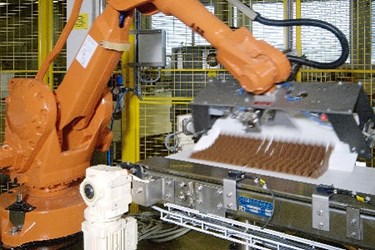Robotics Are Changing The Face Of Food Manufacturing
By Isaac Fletcher, contributing writer, Food Online

Automation has become a critical force in food processing and with new advancements in technology and design of robotic systems, food manufacturers stand to gain monumental value from robotics
It should come as little surprise that robotics and automation have revolutionized the way we look at production lines. With significant increases in efficiency and cost-savings, food processors are looking to robotics to improve manufacturing capabilities and increase profit margins. So, how, exactly, do robotic systems provide these benefits? Robotics can operate in unsafe, hazardous environments that would otherwise be very costly and dangerous for people to work within. These systems are also consistent in accuracy, which reduces the potential for errors and ultimately cuts costs and reduces waste. Furthermore, unlike humans, robotic systems can work continuously with no need for breaks, rest, or holidays.
Guest Column: What’s Driving The Rise Of Robotics In Food Manufacturing?
It is also important to note that robotics excel at tasks that are tedious and repetitive; those which human workers would find boring and menial. When human workers are assigned activities such as these, the rates of accidents and mistakes can be high due to a lack of engagement and focus. Implementing robotics for these jobs is a sure way to reduce human-related errors.
In general, robotic systems are moving away from the traditional large, complex, and expensive machines of the past and making a shift toward smaller systems that are both less expensive and more user-friendly. Newer systems are also capable of adapting to changes in the environment, which can provide numerous advantages over older systems. Dick Slansky, a senior analyst at the ARC Advisory Group, says, “Today’s robotic systems benefit from the latest advancements in artificial intelligence (AI). These AI-software systems allow robots to function more autonomously and to make decisions based on the situations encountered.”
Podcast: The Future Of Robotics In Food Packaging
Robotic systems are no longer just for large manufacturers, either. For example, Rethink Robotics has introduced a robotic industrial aid, Baxter, which makes use of behavior-based common sense to learn skills and adapt to shifting environments. Mitsubishi Electric, a familiar name in robotic systems, is also working toward pushing the limits of speed, accuracy, and compact design. One example of these efforts is the company’s line of MELFA robots which provide long operating life, adaptability, and ease of use. Like most of Mitsubishi’s products, the MELFA robotics are intended to increase productivity, operational efficiency, and energy management, all of which are being achieved through new robotics technology and design.
